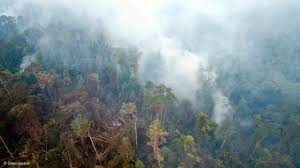The Problem with Palm Oil
Could my soft-spread margarine be contributing to rain forest destruction?
It might not be on everyone’s radar, but palm oil in consumer products is now nearly unavoidable. It is found in some margarines and in about half the packaged products sold in U.S. grocery stores, including popular snack foods like ice cream, cookies, crackers, instant noodles, peanut butter, cereals, and potato chips. Add personal care products to the mix — everything from shampoo to toothpaste — and you will find palm oil products in nearly every room in your house. Additionally, palm is increasingly being used a biofuel.
Why so much palm oil? It is semi solid at room temperature and does not have to be hydrogenated. It keeps well and is stable at high heat. In many products it replaced unhealthy trans fats.
So what’s the problem?

David Wilcove, Princeton University professor of public affairs and ecology and evolutionary biology, has called palm oil “the single greatest immediate threat to tropical forests and wildlife. It is the leading cause of deforestation and has been for a number of years.”
About 85% of the world supply of palm oil comes from Malaysia and Indonesia, with the rest in Africa and South America in a band around the Equator. In Indonesia, burning peat forests to clear land for palm oil plantations not only endangers wildlife but also adds dangerously to global climate change. The Union of Concerned Scientists explains that “[p]eatlands can hold up to 18 to 28 times as much carbon as the forests above them; when they are drained and burned, both carbon and methane are released into the atmosphere—and unless the water table is restored, peatlands continue to decay and release global warming emissions for decades.”
Rainforest Action Network has coined the term Conflict Palm Oil to describe palm oil that is grown on plantations that destroy forests, exploit workers, and endanger animals.
The following is from the introduction to Conflict Palm Oil, a 2013 report by the Rainforest Action Network: “In rainforests half a world away from the United States, orangutans are making their last stand for survival. Scientists warn that these gentle and intelligent animals, among humankind’s closest kin, could become extinct within our lifetime if their rain forest homes continue to be destroyed for palm oil plantations. But the primary threat pushing them toward extinction lies much closer to home than you may think: you’ll find it hidden in the snack food aisle of your local grocery store, and likely in your own shopping cart.

When you eat food that comes out of a bag, a box, or a package of any kind, chances are you are eating palm oil. It is added to chocolate, turned into fry oil, and snuck into snacks of all sorts—in fact, it can now be found in roughly half the packaged food products sold in grocery stores. This palm oil comes at a terrible human and environmental cost. Skyrocketing demand has driven massive, industrial palm oil plantations into millions of acres of formerly lush rainforest habitat in Indonesia and Malaysia, worsening climate change and causing widespread human rights violations.”
Take Action
- Products without Palm Oil lists products, such as food, cleaners, and personal care items, that do not contain palm oil.
- Rainforest Action Project has a project to Stop Deforestation by businesses, with ideas for action.
- The strategy of the World Wildlife Fund is to support sustainable palm oil and avoid boycotts, since they believe that substitutions with other vegetable oils can lead to even further environmental and social harm. WWF supports the Roundtable on Sustainable Palm Oil (RSPO) which sets production standards for growers (revised in 2018) for producing and sourcing palm oil. WWF sees this certification as one tool in addressing the palm oil problem. They publish a Palm Oil Buyers Scorecard, which rates sustainability actions and commitments regarding palm oil.
- Did you find a favorite product containing palm oil? Go the to the company website and check out their palm oil policy. Ask questions!
Updated July, 2023
Resources
Documents
- Chickpea and Cauliflower Curry recipe
- Locally Sourced Food Matrix
- Needham Local Food Sources – excel file
- Needham Local Food Sources – .pdf file
- Quinoa Almond Pilaf recipe
- Ratatouille With Chickpeas
- Resiliency Gardens Project Flyer
- Tunesian Vegetable Stew

